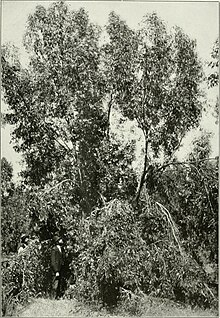Eucalyptus occidentalis
| Eucalyptus occidentalis | |
|---|---|
 |
|
| Scientific classification | |
| Kingdom: | Plantae |
| (unranked): | Angiosperms |
| (unranked): | Eudicots |
| (unranked): | Rosids |
| Order: | Myrtales |
| Family: | Myrtaceae |
| Genus: | Eucalyptus |
| Species: | E. occidentalis |
| Binomial name | |
|
Eucalyptus occidentalis Endl. |
|
| Synonyms | |
|
Eucalyptus agnata Domin Eucalyptus occidentalis var. occidentalis |
|
Eucalyptus agnata Domin Eucalyptus occidentalis var. occidentalis
Eucalyptus occidentalis, commonly known as the flat topped yate or the swamp yate, is a tree that is native to Western Australia. The Noongar names for the tree are Mo or Yundill.
The tree or mallee typically grows to height of 4 to 25 metres (13 to 82 ft) with the diameter of approximately 0.5 metres (1.6 ft). The form of the tree is to usually have a short trunk which branches fairly low to form several stout primary branches. The canopy is predominantly terminal, giving the tree an umbrella-like appearance, and is moderately dense. It forms rough, fibrous and flaky dark grey or black bark mostly on the trunk that becomes conspicuously smooth white, sometimes powdery, on the upper trunk and branches. Adult leaves are glossy-green in colour with a lanceloate shape. Seedling or coppice growth is often present with conspicuous dull blue-green broadly ovate leaves. It flowers early for most Eucalypts, in its first year of growth. It produces cream-white flowers between September and May. Seeds are produced in the fruit and can be collected between October and February. Seeds are blackish-brown in colour 1 to 2 millimetres (0.04 to 0.08 in) long, angularly ovoid or flattened ovoid with 150 to 300 viable seeds per gram.
E. occidentalis is closely related to Eucalyptus sargentii, which is also a rough-barked tree species usually found on saline sites but differing in having terete peduncles, smaller fruit and smaller buds in clusters of seven.
Found in riparian zones as well as in hilly and rocky areas along the south coast of Western Australia in the Great Southern extending north into the southern Wheatbelt and east into the Goldfields-Esperance regions growing in sandy or clay soils.E. occidentalis is widely planted in the drier parts of Victoria, South Australia and in central southern New South Wales. It has grows well on saline, irrigated heavier soils in northern Victoria. It is extensively planted in other temperate regions around the world such as Italy, Morocco, Chile, Mexico and Israel.
...
Wikipedia
